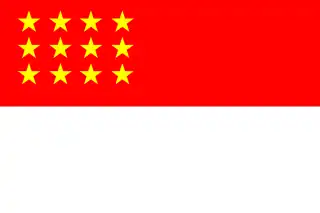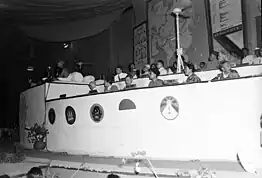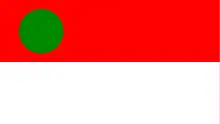Sang Saka Malaya
The Sang Saka Malaya is the flag of the Parti Kebangsaan Melayu Malaya. It is also known as Sang Saka Merah Putih.
 | |
| Sang Saka Merah Putih Bendera Rakyat Bendera Malaya Merdeka | |
| Use | Other |
|---|---|
| Proportion | 1:2 |
| Adopted | Circa 1947 |
| Design | Twelve stars arranged in three rows of four columns on red and white background |
| Designed by | Combined PUTERA-AMCJA |
The flag features twelve stars arranged in three rows of four columns. It was introduced in 1947 by the combination of two political parties, PUTERA and AMCJA, as a proposal to the flag of an independent Federation of Malaya. The twelve stars represent the 12 states of the Malay Peninsula. It follows the concept of the American flag with 50 stars representing the 50 states that make up the United States.
The Sang Saka Malaya flag is the flag of the Left movement fighting for independence without the involvement of the Malay rulers, and therefore can be said to tend towards the formation of a republic, (through integration with Indonesia) the same as happened in Indonesia, where the local kings had been stripped of power.
Sang Saka Malaya (2007)[1] refers to the flag designed by Angkatan Muda Keadilan (PKR Youth) leader, Najwan Halimi. This flag was carried by supporters of Himpunan Janji Demokrasi [2] with the red and white flag design together with the crescent moon and a star with 11 vertices. The Sang Saka Malaya (2007) became the central point in the national flag controversy that had arisen around the 56th anniversary of Malaysia's independence in 2013.
General

It was brought by the delegates of PKMM, led by Dr. Burhanuddin al-Helmy, to the Asian Regional Conference held at the end of 1947 in New Delhi, India.[3][4] However, Angkatan Muda Keadilan (PKR Youth) leader, Najwan Halimi has claimed he was the designer of a similar flag carried by supporters of Himpunan Janji Demokrasi in 2007.[2] The 2007 design red-white flag features the crescent moon and a star with 11 vertices, whilst the Sang Saka Malaya design announced on 11 November 1947 in Singapore is red and white with 12 yellow stars to represent the 12 states in Malaya.[5] The 1947 flag was hoisted for the first time in the Malayan Democratic Union Building, Singapore.[3]
According to blogger Tukar Tiub, Hishamuddin Rais, this flag was later flown during the 1947 Afro-Asian Conference in New Delhi. If he means the Asian-African or Afro-Asian Conference or better known as the Bandung Conference, it is somewhat inaccurate. This is because the first Afro-Asian Conference was held on April 18, 1955 in Bandung, Indonesia. Thus the more accurate is the Asia Regional Conference or Asian Relations Conference at the end of 1947 in New Delhi.[3][4]
According to the book written by Kamarudin Jaffar, Dr. Burhanuddin Al Helmy: Malay and Islamic politics, Dr Burhanuddin has led the Malayan delegation in this conference. The presence of Dr. Burhanuddin, who holds the position of PKMM Advisor, has opened the opportunity for him to meet and discuss movements against colonialism together with the independence leaders of Asian countries.[6] Based on the sources of information, several conclusions can be made that the flag of the Young Malay Union Association, nicknamed Sang Saka Malaya, was first designed in 1947, but its design was not the same as that carried by the participants in the Promise of Democracy.[3][4]
The red and white flag, called just Sang Saka, that was used by groups which supported the creation of Indonesia Raya and its sentiment was first brought to Malaya by Kesatuan Melayu Muda (KMM) in 1938 led by Ibrahim Yaacob.
Kesatuan Melayu Muda (KMM) had been fighting for independence for Malaya to be affiliated with the Republic of Indonesia Raya or Melayu Raya and to set aside the monarchy. However, most of the Malays in Malaya at that time, (circa 1938) did not agree with their cause because the Malays supported the institution of the Malay Rulers and Islam. For the most part, the Malays chose the UMNO struggle to uphold the institution of the Malay Rulers and Islam .
After Kesatuan Melayu Muda (KMM) was banned, the Parti Kebangsaan Melayu Malaya (PKMM) led by Mokhtaruddin Lasso, Dr. Burhanuddin al-Helmy and Ahmad Boestamam continued the ideological struggle.[7] PKMM adopted the Indonesian republican flag as its own.[8]
At midnight on New Year's Eve 2012, a group called "Aktivis Sang Saka" flew the Sang Saka Malaya flag, lofted with a cluster of twelve gas balloons, and then hoisted under the platform of the Masjid Jamek LRT Station above the intersection of Jalan Raja and Jalan Tun Perak, near Dataran Merdeka in the capital of Malaysia, Kuala Lumpur, then taken down by the police 30 minutes later. When questioned by police about half an hour after the incident, one activists, Muhammad Nasir Abu Bakar, said that they were flying the flag to commemorate the Malayan leftist liberation struggle " for transparency and truth."[9]
Usage
The Sang Saka Malaya was flag of the Persatuan Kesatuan Melayu Muda (PKMM a.k.a. Malay Youth Association) which was not aligned to Malayan royalty. It was never officially used by a state in Malaysia and it is simply the flag of the PKMM which never bore the inclusion of the sultans in their struggle. According to the Head of the History, Heritage and Socio-Cultural Unit of the Majlis Professor Negara (MPN a.k.a. National Council of Professors), Prof Datuk Dr Zainal Kling, the Sang Saka (with red and white background only) has been used by states in Maritime Southeast Asia since time immemorial. It was not the original Malayan flag.[10]
Nusantara sentiment
The use of red and white colors on the flags in the states of Nusantara has been used since before the 13th century, as found on the banners of the Majapahit kingdom, Banggai kingdom, Bone state and Soppeng kingdom in South Sulawesi. When Indonesia was colonised by the Dutch for 340 years, Indonesia was forced to use the Dutch flag with three rows of red-white-blue colours. As a symbol of opposition to colonialism, the revolutionary youth tore the last blue row of the Dutch flag in the 'Yamato Hotel incident' in 1945. The blue colour of the colonial flag was considered to symbolise the 'blue blood' or noble blood of the Western colonisers, as found on the flags of the Netherlands, England (Union Jack), France and the United States. The red colour is considered to symbolise the blood spilled during the war of independence and the white colour is considered to symbolise the purity of the people. For the Malays, the sovereignty of kings is expressed through the colour yellow.[11]
Controversy


The issue involving the waving of the Sang Saka Malaya flag started when a group of teenagers who participated in the "Promise of Democracy" parade in conjunction with Malaysia's independence night on August 31, 2012, started waving the flag in public. Simultaneously with the gathering, pamphlets urging the conversion of the Jalur Gemilang to the flag were also distributed.[12] With it, the view that the flying of the flag is a form of ideological threat that wants to change the existing Jalur Gemilang flag arises. Prime Minister Tun Dr Mahathir Mohamad did not reject the possibility that the action of some of the Himpunan Janji Bersih participants in raising another flag to replace Jalur Gemilang had an implicit agenda, as if to acknowledge the dissidents' desire to change the Malaysian system of government to a republic.[13]
"Maybe that's their intention, if Kesatuan Melayu Muda (KMM) is endorsed it is indeed their intention (republic state). I dare not say but it is a possibility,".
— Tun Dr. Mahathir Mohamad
In addition, some protesters also insulted the country's leaders by stepping on the Prime Minister's photo. These actions were widely condemned by many parties[14][15][16] and some even made police reports.[17]
Following the criticism received, the Promise Coalition Committee, Maria Chin Abdullah issued a statement that her party, Bersih, did not give instructions to distribute leaflets changing the Jalur Gemilang to the flag that was waved by a group of teenagers at Dataran Merdeka. In addition, according to Youth Wing Leader of the Angkatan Muda Keadilan (AMK), Shamsul Iskandar Md Akin, the opposition has never discussed the design of the Sang Saka Malaya flag that was redesigned by Najwan Halimi in 2007, who is the Deputy Chief of Information of Angkatan Muda Keadilan (PKR). Shamsul Iskandar described the waving of the flag of Sang Saka Malaya as a manifestation of young people who have bright observations about the history of Nusantara.[18][19]
According to the Sarawak State Pas Youth Council website there is an entry that describes "the Sang Saka Malaya flag will replace the Jalur Gemilang because it has the characteristics of Nusantaran (Sang Saka) that are not on the Jalur Gemilang"[20]
Then also, the concept or element of the red and white stripes is seen not only in the flags of the republics around Nusantara such as those displayed in the national flags of Indonesia and Singapore, but the element also exists in the official flag of the United Malays National Organization (UMNO), the Malaysian Islamic Party (PAS) and Parti Ikatan Bangsa Malaysia (IKATAN).
Gallery
 The Malaysian flag, known as the Jalur Gemilang, also has elements of a red stripe which means bravery and white which means purity.
The Malaysian flag, known as the Jalur Gemilang, also has elements of a red stripe which means bravery and white which means purity. Indonesian Flag, "Sang Saka Merah Putih".
Indonesian Flag, "Sang Saka Merah Putih". In the Singapore flag, there is a red element that symbolizes unity and the white color symbolizes purity.
In the Singapore flag, there is a red element that symbolizes unity and the white color symbolizes purity..svg.png.webp) The flag of the United Malays National Organization or UMNO, "Sang Saka Bangsa", one of the political parties in Malaysia also uses red and white colors with a yellow moon and a green Kris in it.
The flag of the United Malays National Organization or UMNO, "Sang Saka Bangsa", one of the political parties in Malaysia also uses red and white colors with a yellow moon and a green Kris in it. Parti Islam Se-Malaysia or PAS also uses red and white color elements in one version of the official flag.
Parti Islam Se-Malaysia or PAS also uses red and white color elements in one version of the official flag.
References
- Halimi, Najwan. "Sang Saka Malaya". Najwanhalimi.com. Retrieved 28 December 2018.
- "Berita Harian | Motif jelek tukar bendera" (in Malay). Archived from the original on 24 April 2014. Retrieved 6 September 2013.
- 1947: Sang Saka Malaya Dikibar di Luar Negara RAKYAT MARHAEN: 1947 Sang Saka Malaya DIKIBAR DI LUAR NEGARA - Satu Perbincangan.
- Munisamy, Saminathan. "Sang Saka Merah Putih and Malayan Representatives at Asian Relations Conference Delhi 25th March to 2nd April 1947". Retrieved 30 April 2023.
- Generasi Muda Dikelirukan dengan Kibaran "Sang Saka Malaya" - KLPos
- Kamarudin Jaffar (1980). Dr. Burhanuddin AlHelmy, politik Melayu dan Islam. Yayasan Anda. OCLC 7796082.
- "'Sang Saka Malaya' satu pendustaan". Utaranews.com. Retrieved 28 December 2018.
- Sani, Rustam (2008). Social Roots of the Malay Left. SIRD. pp. 29–30. ISBN 978-9833782444.
- Zulaikha Zulkifli (1 January 2013). "'Bendera Rakyat' berkibar di Dataran". MalaysiaKini.com. Archived from the original on 6 March 2013. Retrieved 6 May 2013.
{{cite news}}: CS1 maint: bot: original URL status unknown (link) - Harian, Sinar (26 December 2018). "Nasional". Sinarharian.com.my. Retrieved 28 December 2018.
- BENDERA MALAYSIA
- PKR Deputy Info Chief: 'I Designed Controversial Flag'
- "Tindakan kibar bendera 'Sang Saka Malaya' mahu tukar Malaysia kepada republik?". Archived from the original on 10 September 2012. Retrieved 8 September 2012.
- Farhan Darwis, Mohd (1 September 2012). "Persenda 'Jalur Gemilang' tindakan biadap". themalaysianinsider. Archived from the original on 2 September 2012. Retrieved 30 April 2023 – via Archive.org.
- NASRAH ABDUL RAHIM, WAN (3 September 2012). "PKR bidas cipta 'bendera baru' ganti Jalur Gemilang - Politik - Sinar Harian". sinarharian. Archived from the original on 3 September 2012. Retrieved 30 April 2023 – via Archive.org.
- Farhan Darwis, Mohd (4 September 2012). "Main - Bahasa - PKR kecam kibar bendera ganti Jalur Gemilang @ Sat Sep 01 2012". Archived from the original on 4 September 2012. Retrieved 30 April 2023.
- "Lite - Bahasa - Kibar bendera ganti jalur gemilang: Perkasa buat laporan polis @ Sun Sep 02 2012". 4 September 2012. Archived from the original on 4 September 2012. Retrieved 30 April 2023.
- AMK: Sang Saka Malaya pandangan peribadi Najwan
- AMK nafi mahu tukar jalur gemilang, retrieved 30 April 2023
- "Sang Saka Merdeka atau Sang Saka Malaya atau Sang Saka Malaysia?". Dewan Pemuda PAS Sarawak. 30 August 2009. Retrieved 30 April 2023.